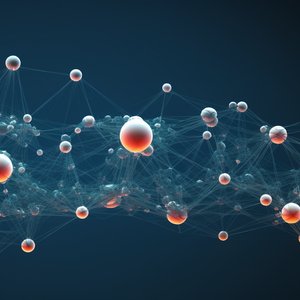

Top Posts
Most Shared
Most Discussed
Most Liked
Most Recent
By Paula Livingstone on Sept. 1, 2022, 8:55 a.m.
Tagged with: Identity Monitoring Connectivity Innovation Cybersecurity Security Technology IIOT Automation Industry 4.0 Control Internet Of Things Sensors Edge Computing Smart Devices
The Industrial Internet of Things (IIoT) is not just a buzzword; it's a transformative force reshaping industries. From manufacturing floors to energy grids, IIoT is the backbone of increased automation and data exchange. This blog aims to delve into one of the most critical components of IIoT endpoints.
Understanding IIoT endpoints is crucial for anyone involved in the design, implementation, or management of industrial systems. These endpoints serve as the interface between the physical and digital worlds, collecting data from the environment and sending it back to the system for analysis. They are the eyes and ears of IIoT, making them indispensable for modern industrial operations.
However, the subject of IIoT endpoints is not just about what they are, but also about how they function within a broader ecosystem. This includes their role in different industries, the measurable and verifiable techniques to assess their performance, and the layers of security that protect them. One of the key aspects we will focus on is Machine-to-Machine (M2M) identity, a concept that is gaining traction for its role in enhancing the security and functionality of IIoT systems.
So, why should you care about IIoT endpoints? Because they are the linchpin of any successful IIoT implementation. Without a deep understanding of what they are, how they work, and how they interact with other components, any IIoT project is bound to face challenges. This blog aims to provide that understanding, offering a comprehensive look at IIoT endpoints and their growing significance in our increasingly connected world.
Let's embark on this journey to understand IIoT endpoints, why they matter, and how they are set to evolve in the future. Whether you are an industry professional, a researcher, or simply someone interested in the future of industrial technology, this blog has something for you.
Similar Posts
Here are some other posts you might enjoy after enjoying this one.
What is an IIoT Endpoint?
An IIoT endpoint is any device or system that serves as a point of interaction within an Industrial Internet of Things network. These endpoints are responsible for generating, processing, routing, or storing data. They act as the interface between the physical world and the digital realm, making them a critical component in any IIoT system.
At its core, an IIoT endpoint is designed to perform specific tasks. These tasks can range from simple data collection via sensors to complex data analytics performed by advanced computing platforms. Regardless of their complexity, all IIoT endpoints have a common goal: to facilitate the seamless flow of information within an industrial system.
It's important to note that IIoT endpoints are not just passive data collectors. They often have the capability to execute commands, make decisions based on the data they collect, and interact with other devices or systems. This makes them an active participant in the IIoT ecosystem, contributing to the overall efficiency and effectiveness of industrial operations.
For example, in a manufacturing setting, an IIoT endpoint could be a sensor that monitors the temperature of a machine. This sensor not only collects data but may also trigger an alert if the temperature exceeds a certain threshold, thereby preventing potential damage or breakdowns.
Understanding what an IIoT endpoint is, therefore, the first step in grasping the broader complexities of Industrial Internet of Things systems. These endpoints are the building blocks that enable the advanced functionalities we associate with smart industries, from real-time monitoring to predictive maintenance.
Types of IIoT Endpoints
IIoT endpoints come in various shapes and sizes, each designed to serve a specific purpose within an industrial system. Broadly speaking, these endpoints can be categorized into sensors, actuators, Programmable Logic Controllers (PLCs), and Remote Terminal Units (RTUs).
Sensors are perhaps the most straightforward type of IIoT endpoint. They collect data from the environment, such as temperature, humidity, or pressure, and send it back to a central system for analysis. Sensors are the eyes and ears of an IIoT system, providing the raw data that drives decision-making.
Actuators, on the other hand, are the muscles of an IIoT system. They receive commands from a central system and perform actions in the physical world, such as opening a valve or turning on a machine. Actuators work in tandem with sensors to create a feedback loop, allowing for real-time adjustments and optimizations.
Programmable Logic Controllers (PLCs) are more complex IIoT endpoints that can execute a series of programmed instructions. These devices are commonly used in manufacturing processes to control machinery and manage workflows. PLCs can integrate data from multiple sensors and actuators to make more nuanced decisions, thereby increasing the efficiency of industrial operations.
Remote Terminal Units (RTUs) serve as a bridge between the field devices like sensors and actuators and the central control system. They collect data from various field devices, process it locally, and then send it to the central system. RTUs are particularly useful in scenarios where quick data processing is essential, such as in energy distribution systems.
Understanding the different types of IIoT endpoints is crucial for designing an effective IIoT system. Each type of endpoint has its own set of capabilities and limitations, which must be considered when planning an IIoT implementation. For instance, while sensors are excellent for data collection, they may lack the computational power to make complex decisions, a task better suited for PLCs.
Moreover, the choice of IIoT endpoints can significantly impact the overall performance and security of an industrial system. For example, using actuators with built-in security features can help mitigate the risks of unauthorized access, a critical consideration in today's increasingly connected industrial landscapes.
The Diversity of IIoT Endpoints
The world of IIoT endpoints is incredibly diverse, not just in terms of types but also in functionalities, capabilities, and applications. This diversity is both a strength and a challenge when it comes to designing and implementing IIoT systems.
For instance, some IIoT endpoints are designed to operate in harsh environments, such as extreme temperatures or high-pressure conditions. These rugged endpoints are built to withstand the elements, ensuring reliable performance even in the most challenging industrial settings.
On the other end of the spectrum are IIoT endpoints designed for precision tasks, such as quality control in manufacturing or patient monitoring in healthcare. These endpoints often come equipped with advanced sensors and computing capabilities, allowing for highly accurate data collection and analysis.
There are also specialized IIoT endpoints that focus on energy efficiency, a growing concern in today's industrial landscape. These devices are designed to minimize power consumption while maintaining high levels of performance, contributing to more sustainable industrial practices.
Moreover, the diversity extends to the communication protocols that IIoT endpoints use. While some may rely on traditional wired connections, others use wireless technologies like Wi-Fi, Bluetooth, or even satellite communication. This flexibility in communication methods allows for greater adaptability in various industrial settings.
Understanding this diversity is crucial for anyone involved in IIoT projects. It allows for better planning, more effective system design, and ultimately, more successful implementations. The diversity of IIoT endpoints means that there is likely a solution for almost any industrial challenge, but it also means that careful consideration is required to select the right endpoints for your specific needs.
As the IIoT landscape continues to evolve, we can expect even greater diversity in the types and functionalities of endpoints. This will open up new possibilities but will also introduce new complexities that will need to be managed. Being aware of this diversity is the first step in navigating these evolving challenges.
The Importance of Understanding IIoT Endpoints
Understanding IIoT endpoints is not just an academic exercise; it's a practical necessity for anyone involved in the industrial sector. The performance, security, and efficiency of an IIoT system are heavily dependent on the endpoints it employs. Therefore, a deep understanding of these components is crucial for the successful deployment and operation of any IIoT system.
One of the key aspects of understanding IIoT endpoints is their role in data collection and analysis. These devices are often the first point of contact for gathering critical operational data. Whether it's a sensor monitoring temperature in a chemical plant or an actuator controlling a robotic arm in a manufacturing line, the data collected by these endpoints can have a significant impact on decision-making processes.
Another important consideration is the security of IIoT endpoints. As the interface between the digital and physical worlds, these devices are potential targets for cyber-attacks. Understanding the various security protocols and measures that can be implemented is essential for protecting not just the endpoints themselves, but the entire IIoT network.
Furthermore, the cost implications of selecting and maintaining IIoT endpoints should not be overlooked. Different types of endpoints come with varying price tags and operational costs. Understanding these financial aspects can help organizations make more informed decisions, balancing initial investment against long-term benefits.
Moreover, the importance of understanding IIoT endpoints extends to compliance with industry standards and regulations. Many industries have specific guidelines concerning data integrity, security, and operational efficiency. Being well-versed in the capabilities and limitations of various IIoT endpoints can aid in ensuring that your system is compliant with these standards.
In summary, understanding IIoT endpoints is a multifaceted endeavor that impacts various aspects of industrial operations. From enhancing data-driven decision-making to ensuring robust security measures, a comprehensive understanding of these devices is indispensable for anyone involved in the IIoT ecosystem.
Measurable and Verifiable Techniques
When it comes to IIoT endpoints, the adage "you can't manage what you can't measure" holds true. Employing measurable and verifiable techniques is essential for assessing the performance, security, and reliability of these devices.
One common method for measuring performance is Key Performance Indicators (KPIs). These are specific metrics that can be used to evaluate the effectiveness of an IIoT endpoint in achieving its objectives. For example, a KPI for a sensor could be its accuracy in data collection, while for an actuator, it could be the speed of response to commands.
Verifiability is equally important, especially in contexts where data integrity is crucial. Techniques such as data logging and timestamping can be employed to ensure that the data collected by IIoT endpoints is both accurate and traceable. This is particularly important in industries like healthcare and energy, where data accuracy can have significant implications.
Another measurable technique involves the use of benchmarks. Benchmarks provide a standard against which the performance of an IIoT endpoint can be compared. This is useful for both system designers and operators, as it allows them to identify areas where improvements can be made.
Security metrics are also a vital part of measurable and verifiable techniques. These could include the frequency of security audits, the number of detected vulnerabilities, or the time taken to patch these vulnerabilities. Such metrics not only help in maintaining the security of IIoT endpoints but also provide a way to demonstrate compliance with industry regulations.
Moreover, the use of simulation and modeling can offer valuable insights into the potential performance of IIoT endpoints under different conditions. These techniques allow for the testing of various scenarios, helping to identify potential issues before they become actual problems.
In summary, employing measurable and verifiable techniques is not just a best practice; it's a necessity for anyone serious about maximizing the effectiveness and security of their IIoT systems. These techniques provide the tools needed to manage and optimize IIoT endpoints, contributing to more successful and reliable industrial operations.
The Role of IIoT Endpoints in Different Industries
The application of IIoT endpoints is not limited to a single industry; they play a pivotal role across various sectors. From manufacturing and energy to healthcare and transportation, IIoT endpoints are revolutionizing the way industries operate.
In manufacturing, for example, IIoT endpoints like sensors and actuators are integral to the automation of production lines. They help in real-time monitoring of machinery, ensuring optimal performance and timely maintenance. This not only improves efficiency but also enhances the quality of the end product.
In the energy sector, IIoT endpoints are used for monitoring and controlling the distribution of electricity, gas, and other resources. Sensors can detect fluctuations in energy consumption, while actuators can adjust the flow of resources accordingly. This leads to more efficient and sustainable energy management.
Healthcare is another industry where IIoT endpoints are making a significant impact. Devices like wearable sensors can monitor patient vitals in real-time, providing healthcare professionals with valuable data for diagnosis and treatment. In some cases, these devices can even alert medical staff to emergencies, potentially saving lives.
Transportation is yet another sector benefiting from IIoT. Sensors and actuators are used in everything from traffic management systems to autonomous vehicles. These endpoints help in optimizing routes, reducing congestion, and improving overall transportation efficiency.
Moreover, in agriculture, IIoT endpoints are used for precision farming. Sensors can monitor soil conditions, weather patterns, and crop health, allowing farmers to make data-driven decisions that improve yield and reduce waste.
In summary, the role of IIoT endpoints varies widely across different industries, but the underlying principle remains the same: these devices enable smarter, more efficient, and more sustainable operations. Understanding the specific needs and challenges of each industry is crucial for the successful implementation of IIoT systems.
M2M Identity in IIoT
Machine-to-Machine (M2M) identity in the context of IIoT is a critical aspect that often goes unnoticed but is vital for the secure and efficient operation of IIoT systems. M2M identity refers to the unique identification and authentication of devices within an IIoT network, allowing them to communicate securely with each other.
Traditionally, M2M identity has been managed through static identifiers like IP addresses or device IDs. However, as IIoT networks grow in complexity and scale, these methods are becoming increasingly insufficient. Dynamic identifiers, cryptographic keys, and even blockchain-based solutions are emerging as more secure and flexible options.
Managing M2M identity is not just about security; it also has implications for system efficiency. Properly identified and authenticated devices can more effectively share data and resources, leading to optimized operations. For example, in a smart grid, authenticated devices can dynamically allocate energy resources based on real-time demand, improving overall efficiency.
Moreover, M2M identity plays a role in data integrity. When devices can securely identify each other, the data they exchange is more likely to be accurate and reliable. This is crucial in applications like healthcare monitoring, where inaccurate data can have severe consequences.
Another dimension to consider is the lifecycle management of M2M identities. As devices get updated, decommissioned, or replaced, their identities must also be managed to ensure continuous secure operation. This involves procedures for secure onboarding, maintenance, and eventual decommissioning of devices.
In summary, M2M identity in IIoT is a multifaceted issue that impacts security, efficiency, and data integrity. As IIoT systems continue to evolve, the methods for managing M2M identity are also likely to become more sophisticated, incorporating advanced technologies like blockchain and artificial intelligence to ensure robust and secure device interactions.
Why M2M Identity Matters
While the concept of M2M identity in IIoT may seem like a technical detail, its importance cannot be overstated. Properly managed M2M identity is a cornerstone for the secure and efficient functioning of any IIoT system.
Firstly, M2M identity is crucial for ensuring the security of an IIoT network. Without proper identification and authentication mechanisms, devices are vulnerable to unauthorized access and manipulation. This could lead to data breaches, operational disruptions, and even physical damage in some cases.
Secondly, M2M identity plays a significant role in data integrity. When devices can securely identify each other, the data they exchange is more likely to be accurate and reliable. This is especially important in sectors like healthcare and manufacturing, where data accuracy is critical for safety and quality assurance.
Moreover, M2M identity is essential for regulatory compliance. Many industries have stringent requirements for data security and integrity, and failure to manage M2M identity effectively can result in non-compliance, leading to penalties and reputational damage.
Additionally, M2M identity facilitates more efficient operations. Authenticated devices can share resources and data more effectively, leading to optimized workflows. For example, in a smart manufacturing setup, machines that can securely identify each other can coordinate tasks to minimize downtime and maximize output.
Lastly, M2M identity is not a static, one-time setup but a dynamic process that evolves with the system. As new devices are added or existing ones are updated, the M2M identity management process must adapt to maintain security and efficiency.
In summary, M2M identity is not just a technical requirement but a critical component that impacts multiple facets of an IIoT system. From security and data integrity to regulatory compliance and operational efficiency, the importance of effectively managing M2M identity in IIoT systems cannot be emphasized enough.
Beyond M2M: Other Layers of Security
While M2M identity is a critical component for securing IIoT systems, it's just one layer in a multi-faceted approach to security. There are other layers that deserve attention to ensure a robust security posture.
Firewalls and intrusion detection systems, for instance, can monitor network traffic and block unauthorized access. These systems act as the first line of defense, preventing external threats from infiltrating the network.
Another layer involves data encryption. Encrypting the data that flows between IIoT endpoints ensures that even if unauthorized access occurs, the data remains unintelligible to the intruder. This is particularly important for industries that handle sensitive information.
Role-based access control is also crucial. This security measure ensures that only authorized personnel can access certain parts of the IIoT system. By limiting access based on roles, the system minimizes the risk of internal threats.
Regular software updates are another key aspect. Outdated software can have vulnerabilities that hackers can exploit. Keeping all devices in the IIoT network up-to-date ensures that they are protected against known security flaws.
Physical security measures, such as secure device housing and tamper-evident seals, can also contribute to a more secure IIoT environment. These measures deter physical tampering, adding an extra layer of security.
Security is a complex, ongoing process that involves multiple layers of protection. While M2M identity is undoubtedly important, it's essential to consider these other layers to build a truly secure IIoT system.
Real-World Applications
IIoT endpoints are not just theoretical constructs; they have practical applications that are transforming industries today. Let's delve into some real-world examples that demonstrate the impact of these devices.
In the automotive industry, IIoT sensors are used for predictive maintenance of machinery. These sensors monitor the condition of equipment and alert operators before a failure occurs, reducing downtime and increasing productivity.
Smart agriculture is another area where IIoT is making a difference. Sensors monitor soil moisture levels, allowing farmers to optimize irrigation and conserve water. Actuators can then control the irrigation systems based on this data, leading to more efficient farming practices.
Healthcare is also benefiting from IIoT technology. Wearable devices can monitor patient vitals and send this information to medical professionals in real-time. This enables quicker response times in emergency situations and improves overall patient care.
In retail, IIoT endpoints like smart shelves and inventory trackers help manage stock levels efficiently. These devices can alert staff when items are running low or even automatically reorder products, streamlining the supply chain.
Energy management is another sector where IIoT is making strides. Smart grids use sensors and actuators to dynamically adjust the distribution of electricity based on real-time demand, reducing waste and improving sustainability.
These examples illustrate the transformative power of IIoT endpoints across various industries. From manufacturing and agriculture to healthcare and retail, these devices are enabling smarter, more efficient operations and have a tangible impact on our daily lives.
Future Trends
The landscape of IIoT is ever-changing, driven by technological advancements and evolving industry needs. As we look to the future, several trends are likely to shape the next phase of IIoT development.
One significant trend is the integration of artificial intelligence and machine learning into IIoT systems. These technologies can analyze the vast amounts of data generated by IIoT endpoints, leading to more intelligent decision-making and automation.
Edge computing is another trend gaining traction. As IIoT networks grow, the ability to process data closer to the source-i.e., the endpoints-becomes increasingly important. This reduces latency and improves real-time decision-making capabilities.
Blockchain technology is also making its way into IIoT, offering enhanced security and transparency. Blockchain can be used for secure, tamper-proof systems, especially in applications that require a high level of trust and verification.
Moreover, the focus on sustainability is likely to influence the development of energy-efficient IIoT endpoints. As industries aim to reduce their carbon footprint, the demand for green technologies within IIoT is expected to rise.
Interoperability will be another key focus. As IIoT ecosystems become more complex, the ability for different systems and devices to work together seamlessly will become increasingly important.
These trends indicate that the future of IIoT is not just about more advanced endpoints but also about smarter, more integrated systems. The convergence of various technologies and the focus on sustainability and interoperability are set to take IIoT to new heights.
Conclusion
The world of Industrial Internet of Things (IIoT) is complex, but it's a complexity that holds immense promise. From manufacturing floors to healthcare facilities, IIoT endpoints are revolutionizing how industries operate.
Understanding these endpoints is not just a technical necessity but a strategic imperative. They serve as the foundation for data collection, security, and operational efficiency. Their role extends across industries, each with its unique set of challenges and opportunities.
Security remains a critical concern, especially as IIoT systems continue to grow in scale and complexity. M2M identity serves as one layer in a multi-layered approach to security, which also includes other measures like data encryption, firewalls, and regular software updates.
Real-world applications of IIoT are already showing significant benefits, from predictive maintenance in manufacturing to real-time patient monitoring in healthcare. These practical applications are a testament to the transformative power of IIoT.
As we look to the future, trends like artificial intelligence, edge computing, and blockchain are set to further evolve the IIoT landscape. These technologies promise to make IIoT systems smarter, more secure, and more efficient.
In summary, IIoT is not a passing trend but a fundamental shift in how industries operate. Its impact is far-reaching, and its potential is still largely untapped. As technology continues to advance, the role of IIoT endpoints in shaping industrial practices will only become more significant.
Start the discussion
Post Discussion
Reply to
Want to get in touch?
I'm always happy to hear from people. If youre interested in dicussing something you've seen on the site or would like to make contact, fill the contact form and I'll be in touch.






No comments yet. Why not be the first to comment?